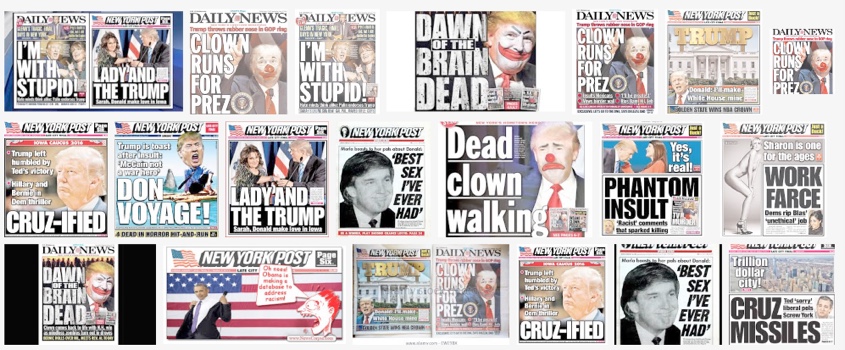P.T. Barnum with Malevolence (Yes, We’re Talking About Donald Trump)

Despite Donald Trump’s unpopularity with New York State voters—71% hold unfavorable views of him, more than any other candidate—it helps to remember that he is the product of New York City and its political culture. His career tells us a lot about changes in a supposedly liberal city and state—especially when it comes to media manipulation, the politics of resentment, and the blurring of public and private interests.
Trump became prominent in New York City during the 1970s, a decade marked by a fiscal crisis, population losses, and shrinking working class and middle class incomes. He rose to power as the liberal city of New Deal New York stumbled. Then he exploited the inequalities, meanness, and celebrity journalism that have risen since its fall.
The fiscal crisis of 1975 halted the kind of governmental programs that had spurred the growth of middle-income housing that Trump’s father built profitably in Brooklyn and Queens. Young Trump looked elsewhere to make a fortune: Manhattan, even though many thought that it too was in a terminal decline.
Trump, raised in the affluent Jamaica Estates section of Queens, in his early years was nevertheless an outsider. In ethnically conscious New York he was a German American—a group nowhere near as prominent as it was a century ago—and not an elite “WASP.”
If his ethnicity was vague, he was still white in a time when the shift in the city and state’s economic order was accompanied by high crime and growth in the city’s Black and Latino communities.
Trump—as would mayors Ed Koch and Rudy Giuliani—spoke to the anger and resentment of working and middle class whites. His campaign lines today about Mexican “rapists” and Muslim terrorists echo his rhetoric in the 1980s about crime and putting fear in the hearts of murderers with the death penalty.
Trump—yesterday, as he does today—articulated and fed on common hatreds and resentments. He could do this without penalties largely because he never held office (which would have made him accountable to voters) and made his living in real estate.
Unlike the other business icons of our era such as Steve Jobs, he has never been associated with a new product or service. He has never led a large, publicly traded company, responsible to stockholders.
Trump’s main business has always been real estate and the acquisition of choice properties, in which government is an essential partner. Tax abatements and devices like the use of eminent domain—which Trump has defended in this campaign—always involve government action.
For this reason, Trump’s view of government resembles that of traditional business-oriented New York Republicans, such as past governors Thomas Dewey and Nelson Rockefeller, and more recently, Mayor Michael Bloomberg—who believed that government should foster business-government partnerships.
His business model has never relied heavily on the competitive advantage of low overseas labor costs. In his political statements, dating back to the 1980s, he has often spoken less about free trade than enhancing domestic production and limiting American overseas commitments.
And Trump, unlike rich men of earlier generations who faced the challenges of activist government and organized labor, rose to power when governments were weaker and unions declining. He exploited this vacuum
Trump conjured himself as a man who could get things done. He was aided in this by the New York City media.
Tabloid journalism is an old art in Gotham, but Trump is in part a product of Rupert Murdoch’s New York Post, which emerged in the late 1970s, just as Trump was making his initial splash. They were made for each other. “Best Sex I’ve Ever Had,” gushed Marla Maples on a Post front page in 1990. The headline accompanied a smirking photo of Trump and the caption, “We always knew that Donald Trump was a tiger in the corporate boardroom, but now we know he’s a wildcat in the bedroom, too.”
Trump became a high/low act, quoted in both gossip columns and the business and politics pages. Taking a lesson from the real estate business, where the perception of a property translates into economic value, Trump turned the spotlights on himself.
He learned that continually upping the ante on his own outrageousness was the best way to retain media attention. Trump’s biggest problem with “political correctness” is that politeness is boring.
When the media system around him evolved, so did his public relations strategy. He fed and exploited the rise of reality television in his show “The Apprentice,” then moved on to use social media as a campaign tool.
Trump linked himself to the reappearance of prosperity and even luxury in New York City. The achievement was hardly his alone, and it has come with deeply unpopular economic inequalities.
Still, when Trump is campaigning, a glistening Gotham makes people believe him when he vows to “make American great again.”
Trump may not be particularly popular as a candidate in his hometown, but his career tells us some uncomfortable truths about the recent history of New York City.
Perhaps the most illuminating comparison is not to another politician but to a different New York type, the showman. Trump is P.T. Barnum with malevolence.
With Trump, as was once so with Barnum, people know that on some level that they are being fooled. Nevertheless, they enjoy the anger, the bombast, the exaggeration, the canned and phony “honesty.” They like being in on the joke and part of the action.
Trump has long operated in an arena in which most people don’t really believe what he is saying, and most people don’t care. He is less a con man (though he is that, too, when he exaggerates his wealth and real estate empire) than a showman—and “reality” is his “show.”
The only problem is that he is not running a dime museum and freak show in nineteenth century New York, but running for the White House.